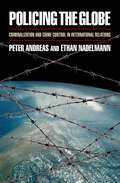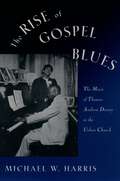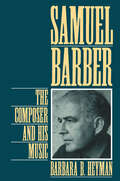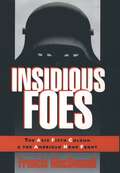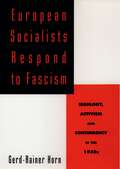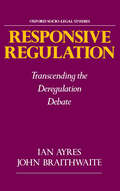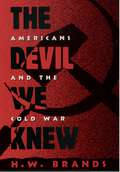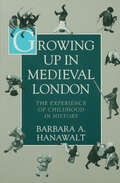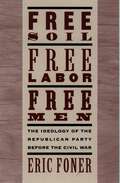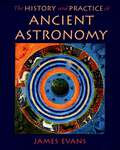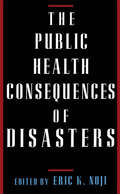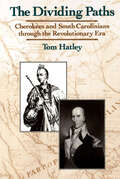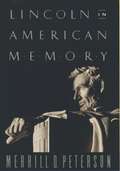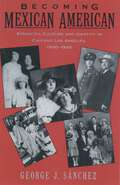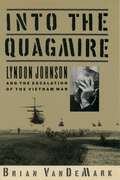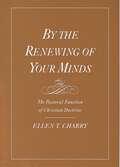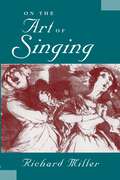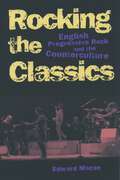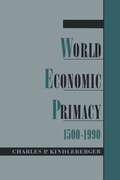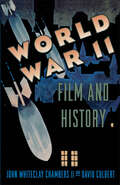- Table View
- List View
Policing the Globe: Criminalization and Crime Control in International Relations
by Peter Andreas Ethan NadelmannIn this illuminating history that spans past campaigns against piracy and slavery to contemporary campaigns against drug trafficking and transnational terrorism, Peter Andreas and Ethan Nadelmann explain how and why prohibitions and policing practices increasingly extend across borders. The internationalization of crime control is too often described as simply a natural and predictable response to the growth of transnational crime in an age of globalization. Andreas and Nadelmann challenge this conventional view as at best incomplete and at worst misleading. The internationalization of policing, they demonstrate, primarily reflects ambitious efforts by generations of western powers to export their own definitions of "crime," not just for political and economic gain but also in an attempt to promote their own morals to other parts of the world. A thought-provoking analysis of the historical expansion and recent dramatic acceleration of international crime control, Policing the Globe provides a much-needed bridge between criminal justice and international relations on a topic of crucial public importance.
The Rise of Gospel Blues: The Music of Thomas Andrew Dorsey in the Urban Church
by Michael W. HarrisMost observers believe that gospel music has been sung in African-American churches since their organization in the late 1800s. Yet nothing could be further from the truth, as Michael W. Harris's history of gospel blues reveals. Tracing the rise of gospel blues as seen through the career of its founding figure, Thomas Andrew Dorsey, Harris tells the story of the most prominent person in the advent of gospel blues. Also known as "Georgia Tom," Dorsey had considerable success in the 1920s as a pianist, composer, and arranger for prominent blues singes including Ma Rainey. In the 1930s he became involved in Chicago's African-American, old-line Protestant churches, where his background in the blues greatly influenced his composing and singing. Following much controversy during the 1930s and the eventual overwhelming response that Dorsey's new form of music received, the gospel blues became a major force in African-American churches and religion. His more than 400 gospel songs and recent Grammy Award indicate that he is still today the most prolific composer/publisher in the movement. Delving into the life of the central figure of gospel blues, Harris illuminates not only the evolution of this popular musical form, but also the thought and social forces that forged the culture in which this music was shaped.
Samuel Barber: The Composer and His Music
by Barbara B. HeymanSamuel Barber (1910-1981) was one of the most important and honored American composers of the twentieth century. Writing in a great variety of musical forms--symphonies, concertos, operas, vocal music, and chamber music--he infused his works with poetic lyricism and gave tonal language and forms new vitality. His rich legacy includes such famous compositions as the Adagio for Strings, the orchestral song Knoxville: Summer of 1915, three concertos, and his two operas, the Pulitzer Prize-winning Vanessa and Antony and Cleopatra, a commissioned work that opened the new Metropolitan Opera House at Lincoln Center. Generously documented by letters, sketchbooks, original musical manuscripts, and interviews with friends, colleagues and performers with whom he worked, this is the first book to cover Barber's entire career and all of his compositions. The biographical material on Barber is closely interspersed with a discussion of his music, displaying Barber's creative processes at work from his early student compositions to his mature masterpieces. Heyman also provides the social context in which this major composer grew: his education, how he built his career, the evolving musical tastes of American audiences, his relationship to musical giants like Serge Koussevitzky, and the role of radio in the promotion of his music. A testament to the significance of the new Romanticism, Samuel Barber stands as a model biography of an important American musical figure.
Insidious Foes: The Axis Fifth Column and the American Home Front
by Francis MacDonnellNazi Germany's efforts to weaken the United States by subversion failed miserably. Bungling spies were captured and half-hearted efforts at sabotage came to nothing. Yet anyone who lived through WWII remembers the chilling posters warning Americans that "Enemy Agents Have Big Ears" and "Loose Lips Sink Ships." Even Superman joined the struggle against these insidious foes. In 1940, polls showed that 71% of Americans believed a Nazi Fifth Column had penetrated the country. Almost half were convinced that spies, saboteurs, dupes, and rumor-mongers lurked in their own neighborhoods and work-places. These fears extended to the White House and Congress. In this book, Francis MacDonnell explains the origins and consequences of America's Fifth Column panic, arguing that conviction and expedience encouraged President Roosevelt, the FBI, Congressmen, Churchill's government, and Hollywood to legitimate and exacerbate American's fears. Gravely weakening the isolationists, fostering Congress's role in rooting out Un-American activities, and instigating the creation of the modern intelligence establishment, the Fifth Column scare did far more than sell movie tickets, comic books, and pulp fiction. Insidious Foes traces the panic from its origins in the minds of reasonable Americans who saw the vulnerability of their open society in an age of encroaching totalitarianism.
European Socialists Respond to Fascism: Ideology, Activism and Contingency in the 1930s
by Gerd-Rainer HornBased on documents collected in six European countries, European Socialists Respond to Fascism: Ideology, Activism and Contingency in the 1930s is a transnational study of largely parallel developments in Austria, Belgium, France, Germany, and Spain in the years 1933-1936. Triggered into action by the shock effect of the Nazi rise to power in Germany, socialists throughout Western Europe entered an unusually active period of practical reorientation and debate over political strategy which helped determine the contours of European politics up to the outbreak of World War II and beyond. Stressing the transnational dimension of this process while simultaneously integrating local, regional, and national factors, this work finds that it was social democracy, rather than communism, that acted as the primary vehicle for radical change among European marxists during the 1930s. Following major figures within the European left and the significant events that made up the inter-war period, Gerd-Rainer Horn demonstrates the interconnectedness of Europe's interwar socialists. Finally, Horn manages to relate these findings to the ongoing interdisciplinary debate on structure, agency, and contingency in the historical process.
Responsive Regulation: Transcending the Deregulation Debate (Oxford Socio-Legal Studies)
by Ian Ayres John BraithwaiteThis book transcends current debate on government regulation by lucidly outlining how regulations can be a fruitful combination of persuasion and sanctions. The regulation of business by the United States government is often ineffective despite being more adversarial in tone than in other nations. The authors draw on both empirical studies of regulation from around the world and modern game theory to illustrate innovative solutions to this problem. Their ideas include an argument for the empowerment of private and public interest groups in the regulatory process and a provocative discussion of how the government can support and encourage industry self-regulation.
The Devil We Knew: Americans and the Cold War
by H. W. BrandsIn the late 1950s, Washington was driven by its fear of communist subversion: it saw the hand of Kremlin behind developments at home and across the globe. The FBI was obsessed with the threat posed by American communist party--yet party membership had sunk so low, writes H.W. Brands, that it could have fit "inside a high-school gymnasium," and it was so heavily infiltrated that J. Edgar Hoover actually contemplated using his informers as a voting bloc to take over the party. Abroad, the preoccupation with communism drove the White House to help overthrow democratically elected governments in Guatemala and Iran, and replace them with dictatorships. But by then the Cold War had long since blinded Americans to the ironies of their battle against communism. In The Devil We Knew, Brands provides a witty, perceptive history of the American experience of the Cold War, from Truman's creation of the CIA to Ronald Reagan's creation of SDI. Brands has written a number of highly regarded works on America in the twentieth century; here he puts his experience to work in a volume of impeccable scholarship and exceptional verve. He turns a critical eye to the strategic conceptions (and misconceptions) that led a once-isolationist nation to pursue the war against communism to the most remote places on Earth. By the time Eisenhower left office, the United States was fighting communism by backing dictators from Iran to South Vietnam, from Latin America to the Middle East--while engaging in covert operations the world over. Brands offers no apologies for communist behavior, but he deftly illustrates the strained thinking that led Washington to commit gravely disproportionate resources (including tens of thousands of lives in Korea and Vietnam) to questionable causes. He keenly analyzes the changing policies of each administration, from Nixon's juggling (SALT talks with Moscow, new relations with Ccmmunist China, and bombing North Vietnam) to Carter's confusion to Reagan's laserrattling. Equally important is his incisive, often amusing look at how the anti-Soviet struggle was exploited by politicians, industrialists, and government agencies. He weaves in deft sketches of figures like Barry Goldwater and Henry Jackson (who won a Senate seat with the promise, "Many plants will be converting from peace time to all-out defense production"). We see John F. Kennedy deliver an eloquent speech in 1957 defending the rising forces of nationalism in Algeria and Vietnam; we also see him in the White House a few years later, ordering a massive increase in America's troop commitment to Saigon. The book ranges through the economics and psychology of the Cold War, demonstrating how the confrontation created its own constituencies in private industry and public life. In the end, Americans claimed victory in the Cold War, but Brands's account gives us reason to tone down the celebrations. "Most perversely," he writes, "the call to arms against communism caused American leaders to subvert the principles that constituted their country's best argument against communism." This far-reaching history makes clear that the Cold War was simultaneously far more, and far less, than we ever imagined at the time.
Growing Up in Medieval London: The Experience of Childhood in History
by Barbara A. HanawaltWhen Barbara Hanawalt's acclaimed history The Ties That Bound first appeared, it was hailed for its unprecedented research and vivid re-creation of medieval life. David Levine, writing in The New York Times Book Review, called Hanawalt's book "as stimulating for the questions it asks as for the answers it provides" and he concluded that "one comes away from this stimulating book with the same sense of wonder that Thomas Hardy's Angel Clare felt [:] 'The impressionable peasant leads a larger, fuller, more dramatic life than the pachydermatous king.'" Now, in Growing Up in Medieval London, Hanawalt again reveals the larger, fuller, more dramatic life of the common people, in this instance, the lives of children in London. Bringing together a wealth of evidence drawn from court records, literary sources, and books of advice, Hanawalt weaves a rich tapestry of the life of London youth during the fourteenth and fifteenth centuries. Much of what she finds is eye opening. She shows for instance that--contrary to the belief of some historians--medieval adults did recognize and pay close attention to the various stages of childhood and adolescence. For instance, manuals on childrearing, such as "Rhodes's Book of Nurture" or "Seager's School of Virtue," clearly reflect the value parents placed in laying the proper groundwork for a child's future. Likewise, wardship cases reveal that in fact London laws granted orphans greater protection than do our own courts. Hanawalt also breaks ground with her innovative narrative style. To bring medieval childhood to life, she creates composite profiles, based on the experiences of real children, which provide a more vivid portrait than otherwise possible of the trials and tribulations of medieval youths at work and at play. We discover through these portraits that the road to adulthood was fraught with danger. We meet Alison the Bastard Heiress, whose guardians married her off to their apprentice in order to gain control of her inheritance. We learn how Joan Rawlyns of Aldenham thwarted an attempt to sell her into prostitution. And we hear the unfortunate story of William Raynold and Thomas Appleford, two mercer's apprentices who found themselves forgotten by their senile master, and abused by his wife. These composite portraits, and many more, enrich our understanding of the many stages of life in the Middle Ages. Written by a leading historian of the Middle Ages, these pages evoke the color and drama of medieval life. Ranging from birth and baptism, to apprenticeship and adulthood, here is a myth-shattering, innovative work that illuminates the nature of childhood in the Middle Ages.
Free Soil, Free Labor, Free Men: The Ideology of the Republican Party before the Civil War
by Eric FonerSince its publication twenty-five years ago, Free Soil, Free Labor, Free Men has been recognized as a classic, an indispensable contribution to our understanding of the causes of the American Civil War. A key work in establishing political ideology as a major concern of modern American historians, it remains the only full-scale evaluation of the ideas of the early Republican party. Now with a new introduction, Eric Foner puts his argument into the context of contemporary scholarship, reassessing the concept of free labor in the light of the last twenty-five years of writing on such issues as work, gender, economic change, and political thought. A significant reevaluation of the causes of the Civil War, Foner's study looks beyond the North's opposition to slavery and its emphasis upon preserving the Union to determine the broader grounds of its willingness to undertake a war against the South in 1861. Its search is for those social concepts the North accepted as vital to its way of life, finding these concepts most clearly expressed in the ideology of the growing Republican party in the decade before the war's start. Through a careful analysis of the attitudes of leading factions in the party's formation (northern Whigs, former Democrats, and political abolitionists) Foner is able to show what each contributed to Republican ideology. He also shows how northern ideas of human rights--in particular a man's right to work where and how he wanted, and to accumulate property in his own name--and the goals of American society were implicit in that ideology. This was the ideology that permeated the North in the period directly before the Civil War, led to the election of Abraham Lincoln, and led, almost immediately, to the Civil War itself. At the heart of the controversy over the extension of slavery, he argues, is the issue of whether the northern or southern form of society would take root in the West, whose development would determine the nation's destiny. In his new introductory essay, Foner presents a greatly altered view of the subject. Only entrepreneurs and farmers were actually "free men" in the sense used in the ideology of the period. Actually, by the time the Civil War was initiated, half the workers in the North were wage-earners, not independent workers. And this did not account for women and blacks, who had little freedom in choosing what work they did. He goes onto show that even after the Civil War these guarantees for "free soil, free labor, free men" did not really apply for most Americans, and especially not for blacks. Demonstrating the profoundly successful fusion of value and interest within Republican ideology prior to the Civil War, Free Soil, Free Labor, Free Men remains a classic of modern American historical writing. Eloquent and influential, it shows how this ideology provided the moral consensus which allowed the North, for the first time in history, to mobilize an entire society in modern warfare.
The History and Practice of Ancient Astronomy
by James EvansThe History and Practice of Ancient Astronomy combines new scholarship with hands-on science to bring readers into direct contact with the work of ancient astronomers. While tracing ideas from ancient Babylon to sixteenth-century Europe, the book places its greatest emphasis on the Greek period, when astronomers developed the geometric and philosophical ideas that have determined the subsequent character of Western astronomy. The author approaches this history through the concrete details of ancient astronomical practice. Carefully organized and generously illustrated, the book can teach readers how to do real astronomy using the methods of ancient astronomers. For example, readers will learn to predict the next retrograde motion of Jupiter using either the arithmetical methods of the Babylonians or the geometric methods of Ptolemy. They will learn how to use an astrolabe and how to design sundials using Greek and Roman techniques. The book also contains supplementary exercises and patterns for making some working astronomical instruments, including an astrolabe and an equatorium. More than a presentation of astronomical methods, the book provides a critical look at the evidence used to reconstruct ancient astronomy. It includes extensive excerpts from ancient texts, meticulous documentation, and lively discussions of the role of astronomy in the various cultures. Accessible to a wide audience, this book will appeal to anyone interested in how our understanding of our place in the universe has changed and developed, from ancient times through the Renaissance.
The Public Health Consequences of Disasters
by Eric K. NojiNatural and man-made disasters--earthquakes, floods, volcanic eruptions, industrial crises, and many others--have claimed more than 3 million lives during the past 20 years, adversely affected the lives of at least 800 million people, and caused more than 50 billion dollars in property damages. A major disaster occurs almost daily in some part of the world. Increasing population densities in flood plains, along vulnerable coastal areas, and near dangerous faults in the earth's crust, as well as the rapid industrialization of developing economies are factors likely to make the threat posed by natural disasters much bigger in the future. Illustrated with examples from recent research in the field, this book summarizes the most pertinent and useful information about the public health impact of natural and man-made disasters. It is divided into four sections dealing with general concerns, geophysical events, weather-related problems, and human-generated disasters. The author starts with a comprehensive discussion of the concepts and role of surveillance and epidemiology, highlighting general environmental health concerns, such as sanitation, water, shelter, and sewage. The other chapters, based on a variety of experiences and literature drawn from both developing and industrialized countries, cover discrete types of natural and technological hazards, addressing their history, origin, nature, observation, and control. Throughout the book the focus is on the level of epidemiologic knowledge on each aspect of natural and man-made disasters. Exposure-, disease-, and health-event surveillance are stressed because of the importance of objective data to disaster epidemiology. In addition, Noji pays particular attention to prevention and control measures, and provides practical recommendations in areas in which the public health practitioner needs more useful information. He advocates stronger epidemiologic awareness as the basis for better understanding and control of disasters. A comprehensive theoretical and practical treatment of the subject, The Public Health Consequences of Disasters is an invaluable tool for epidemiologists, disaster relief specialists, and physicians who treat disaster victims.
The Dividing Paths: Cherokees and South Carolinians through the Era of Revolution
by Tom HatleyFocusing on the American Cherokee people and the South Carolina settlers, this book traces the two cultures and their interactions from 1680, when Charleston was established as the main town in the region, until 1785, when the Cherokees first signed a treaty with the United States. Hatley retrieves the unfamiliar dimensions of a world in which Native Americans were at the center of Southern geopolitics and in which radically different social assumptions about the obligations of power, the place of women, and the use of the land fed the formative cultural psychology of the colonial South. Weaving together firsthand accounts, journals, and letters to give a human reality to the facts of war, politics, and the economy, he pinpoints the revolutionary decade--from the little known but decisive Cherokee war through the Revolution itself--in which both societies struggled over their own identities. Rather than focusing on the Cherokees and Carolinians separately, this book focuses on contacts, encounters, exchanges, intersections: their mutual history. Hatley argues that Cherokee and colonial histories cannot be understood separately--that they are inextricably linked--and that the origins of distinctive features of Native American and colonial ethnicity and seemingly unrelated twists in the political history of each society are rooted in this encounter.
Lincoln in American Memory
by Merrill D. PetersonLincoln's death, like his life, was an event of epic proportions. When the president was struck down at his moment of triumph, writes Merrill Peterson, "sorrow--indescribable sorrow" swept the nation. After lying in state in Washington, Lincoln's body was carried by a special funeral train to Springfield, Illinois, stopping in major cities along the way; perhaps a million people viewed the remains as memorial orations rang out and the world chorused its sincere condolences. It was the apotheosis of the martyred President--the beginning of the transformation of a man into a mythic hero. In Lincoln in American Memory, historian Merrill Peterson provides a fascinating history of Lincoln's place in the American imagination from the hour of his death to the present. In tracing the changing image of Lincoln through time, this wide-ranging account offers insight into the evolution and struggles of American politics and society--and into the character of Lincoln himself. Westerners, Easterners, even Southerners were caught up in the idealization of the late President, reshaping his memory and laying claim to his mantle, as his widow, son, memorial builders, and memorabilia collectors fought over his visible legacy. Peterson also looks at the complex responses of blacks to the memory of Lincoln, as they moved from exultation at the end of slavery to the harsh reality of free life amid deep poverty and segregation; at more than one memorial event for the great emancipator, the author notes, blacks were excluded. He makes an engaging examination of the flood of reminiscences and biographies, from Lincoln's old law partner William H. Herndon to Carl Sandburg and beyond. Serious historians were late in coming to the topic; for decades the myth-makers sought to shape the image of the hero President to suit their own agendas. He was made a voice of prohibition, a saloon-keeper, an infidel, a devout Christian, the first Bull Moose Progressive, a military blunderer and (after the First World War) a military genius, a white supremacist (according to D.W. Griffith and other Southern admirers), and a touchstone for the civil rights movement. Through it all, Peterson traces five principal images of Lincoln: the savior of the Union, the great emancipator, man of the people, first American, and self-made man. In identifying these archetypes, he tells us much not only of Lincoln but of our own identity as a people.
Becoming Mexican American: Ethnicity, Culture, and Identity in Chicano Los Angeles, 1900-1945
by George J. SanchezTwentieth-century Los Angeles has been the locus of one of the most profound and complex interactions between variant cultures in American history. Yet this study is among the first to examine the relationship between ethnicity and identity among the largest immigrant group to that city. By focusing on Mexican immigrants to Los Angeles from 1900 to 1945, George J. Sánchez explores the process by which temporary sojourners altered their orientation to that of permanent residents, thereby laying the foundation for a new Mexican-American culture. Analyzing not only formal programs aimed at these newcomers by the United States and Mexico, but also the world created by these immigrants through family networks, religious practice, musical entertainment, and work and consumption patterns, Sánchez uncovers the creative ways Mexicans adapted their culture to life in the United States. When a formal repatriation campaign pushed thousands to return to Mexico, those remaining in Los Angeles launched new campaigns to gain civil rights as ethnic Americans through labor unions and New Deal politics. The immigrant generation, therefore, laid the groundwork for the emerging Mexican-American identity of their children.
Into the Quagmire: Lyndon Johnson and the Escalation of the Vietnam War
by Brian VanDeMarkIn November of 1964, as Lyndon Johnson celebrated his landslide victory over Barry Goldwater, the government of South Vietnam lay in a shambles. Ambassador Maxwell Taylor described it as a country beset by "chronic factionalism, civilian-military suspicion and distrust, absence of national spirit and motivation, lack of cohesion in the social structure, lack of experience in the conduct of government." Virtually no one in the Johnson Administration believed that Saigon could defeat the communist insurgency--and yet by July of 1965, a mere nine months later, they would lock the United States on a path toward massive military intervention which would ultimately destroy Johnson's presidency and polarize the American people. Into the Quagmire presents a closely rendered, almost day-by-day account of America's deepening involvement in Vietnam during those crucial nine months. Mining a wealth of recently opened material at the Lyndon Baines Johnson Library and elsewhere, Brian VanDeMark vividly depicts the painful unfolding of a national tragedy. We meet an LBJ forever fearful of a conservative backlash, which he felt would doom his Great Society, an unsure and troubled leader grappling with the unwanted burden of Vietnam; George Ball, a maverick on Vietnam, whose carefully reasoned (and, in retrospect, strikingly prescient) stand against escalation was discounted by Rusk, McNamara, and Bundy; and Clark Clifford, whose last-minute effort at a pivotal meeting at Camp David failed to dissuade Johnson from doubling the number of ground troops in Vietnam. What comes across strongly throughout the book is the deep pessimism of all the major participants as things grew worse--neither LBJ, nor Bundy, nor McNamara, nor Rusk felt confident that things would improve in South Vietnam, that there was any reasonable chance for victory, or that the South had the will or the ability to prevail against the North. And yet deeper into the quagmire they went. Whether describing a tense confrontation between George Ball and Dean Acheson ("You goddamned old bastards," Ball said to Acheson, "you remind me of nothing so much as a bunch of buzzards sitting on a fence and letting the young men die") or corrupt politicians in Saigon, VanDeMark provides readers with the full flavor of national policy in the making. More important, he sheds greater light on why America became entangled in the morass of Vietnam.
By the Renewing of Your Minds: The Pastoral Function of Christian Doctrine
by Ellen T. CharryThis book develops the thesis that classical Christian theology seeks to help believers flourish by knowing and loving God. Ellen Charry argues this premise by example, offering a close reading of a number of classical texts, from the New Testament era to the Reformation, including works of Paul, Augustine, Athanasius, Basil of Caesarea, Anselm, and Calvin. She points out the pastoral and moral aims that shape the teachings of these theologians on a wide range of topics, including the Trinity; human beings as created in the image of God; the incorporation of Jews and Gentiles into the body of Christ in baptism; the incarnation, death, and resurrection of Christ; and the divinity of the Holy Spirit. Charry explains that the very logic of their arguments is shaped by the author's concern for the goodness and happiness that should result from living into the doctrines. She further shows that although the spiritual and pastoral purposes of these writings are many and complex, they are invariably concerned to foster what modern people can, without difficulty, recognize as human dignity--what she calls "excellence"--in action, affection, and self-appraisal.
On the Art of Singing
by Richard MillerThis engaging and long influential collection of essays looks at the art of singing in its totality. Written in a lively, non-technical style, On the Art of Singing is a comprehensive manual that deals with all aspects of singing, from the physiology and acoustics of the singing voice to career-building. Divided into four main sections -- vocal technique, style and interpretation, professional preparation, and vocal pedagogy - the book's structure is such that the reader may pick and choose as personal interests and needs dictate. Containing essential information for all singers, including original research on the mechanics of the voice, this book collects in one volume everything that renowned instructor and singer Richard Miller considers essential to the art of vocal performance. To anyone seeking that elusive state of vocal freedom, whether as a singer or instructor of singers, and to anyone else interested in voice, vocal technique or vocal performance, On the Art of Singing will prove an indispensible guide.
Rocking the Classics: English Progressive Rock and the Counterculture
by Edward MacanFew styles of popular music have generated as much controversy as progressive rock, a musical genre best remembered today for its gargantuan stage shows, its fascination with epic subject matter drawn from science fiction, mythology, and fantasy literature, and above all for its attempts to combine classical music's sense of space and monumental scope with rock's raw power and energy. Its dazzling virtuosity and spectacular live concerts made it hugely popular with fans during the 1970s, who saw bands such as King Crimson, Emerson, Lake and Palmer, Yes, Genesis, Pink Floyd, and Jethro Tull bring a new level of depth and sophistication to rock. On the other hand, critics branded the elaborate concerts of these bands as self- indulgent and materialistic. They viewed progressive rock's classical/rock fusion attempts as elitist, a betrayal of rock's populist origins. In Rocking the Classics, the first comprehensive study of progressive rock history, Edward Macan draws together cultural theory, musicology, and music criticism, illuminating how progressive rock served as a vital expression of the counterculture of the late 1960s and 1970s. Beginning with a description of the cultural conditions which gave birth to the progressive rock style, he examines how the hippies' fondness for hallucinogens, their contempt for Establishment-approved pop music, and their fascination with the music, art, and literature of high culture contributed to this exciting new genre. Covering a decade of music, Macan traces progressive rock's development from the mid- to late-sixties, when psychedelic bands such as the Moody Blues, Procol Harum, the Nice, and Pink Floyd laid the foundation of the progressive rock style, and proceeds to the emergence of the mature progressive rock style marked by the 1969 release of King Crimson's album In the Court of the Crimson King. This "golden age" reached its artistic and commercial zenith between 1970 and 1975 in the music of bands such as Jethro Tull, Yes, Genesis, ELP, Gentle Giant, Van der Graaf Generator, and Curved Air. In turn, Macan explores the conventions that govern progressive rock, including the visual dimensions of album cover art and concerts, lyrics and conceptual themes, and the importance of combining music, visual motif, and verbal expression to convey a coherent artistic vision. He examines the cultural history of progressive rock, considering its roots in a bohemian English subculture and its meteoric rise in popularity among a legion of fans in North America and continental Europe. Finally, he addresses issues of critical reception, arguing that the critics' largely negative reaction to progressive rock says far more about their own ambivalence to the legacy of the counterculture than it does about the music itself. An exciting tour through an era of extravagant, mind-bending, and culturally explosive music, Rocking the Classics sheds new light on the largely misunderstood genre of progressive rock.
World Economic Primacy: 1500-1990
by Charles P. KindlebergerCharles Kindleberger's World Economic Primacy: 1500-1990 is a work of rare ambition and scope from one of our most respected economic historians. Extending over broad ranges of both history and geography, the work considers what it is that enables countries to achieve, at some period in their history, economic superiority over other countries, and what it is that makes them decline. Kindleberger begins with the Italian city-states in the fourteenth century, and traces the changing evolution of world economic primacy as it moves to Portugal and Spain, to the Low countries, to Great Britain, and to the United States, addressing the question of alleged U.S. decline. Additional chapters treat France as a perennial challenger, Germany which has twice aggressively sought superiority, and Japan, which may or may not become a candidate for the role of "number one." Kindleberger suggests that the economic vitality of a given country goes through a trajectory that can usefully (thought not precisely) be compared to a human life cycle. Like human beings, the growth of a state can be cut off by accident or catastrophe short of old age; unlike human beings, however, economies can have a second birth. In World Economic Primacy, Kindleberger takes into account the influence of complex historical, social, and cultural factors that determine economic leadership. A brilliant overview of the position of nations in the world economy, World Economic Primacy conveys profound insights into the causes of the rise and decline of the world's economic powers, past and present.
